Most Costly Home Improvement Mistakes
- Homeowner
- /
- Most Costly Home Improvement Mistakes
Completing a home improvement project with your own hands produces a sense of pride and fulfillment that you can’t get from hiring professionals. But, to ensure your hard work doesn’t go to waste, it’s important to have the proper protection.
If your home insurance policy doesn’t accurately reflect your property’s value in your coverage limits, your DIY projects could be at risk. The replacement cost of your home changes over time due to changing labor and supply costs. And, if you improve or renovate your home, you’re changing the value even further. This is good for your quality of life and your home equity, but it could spell trouble if the increase in your house’s value isn’t reflected in your insurance coverage.
Speaking of renovations, we asked over 1,000 homeowners about their attempts at DIY home improvement projects and got some words of wisdom for those thinking of picking up a hammer. Keep reading to find out some of the top home improvements people made and the cost of these projects, as well as some common home renovation mistakes to avoid and other DIY fails.
Why DIY?
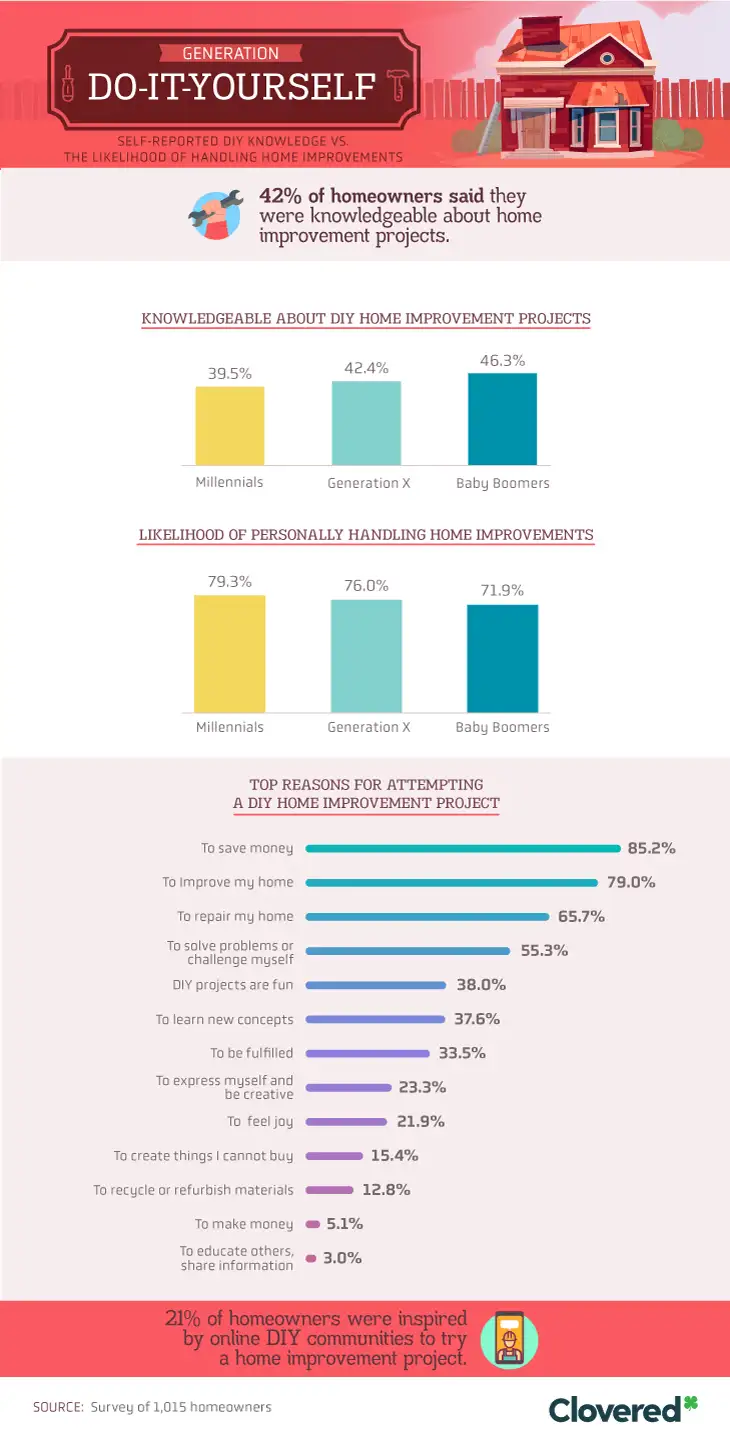
It can be hard to truly understand do-it-yourself projects until you, well, do one yourself. Perhaps experience plays a role in baby boomers being the most knowledgeable about DIY when it comes to home improvement projects.
Compared to more than 46 percent of baby boomers reporting to be knowledgeable about these DIY projects, less than 40 percent of millennials admitted as much. Ironically, though, millennials are the most likely to handle home improvement projects by themselves and baby boomers the least.
If the majority across all generations doesn’t consider themselves particularly knowledgeable about DIY projects, why are so many people doing them?
Eighty-five percent take a project upon themselves as a way to save money, and almost 80 percent do one to improve their home. While many DIY home improvements can often be the best option for budgets, they have positive effects on more than just your wallet.
Thirty-eight percent attempt DIY projects simply because they find them fun, over 23 percent feel they help them express themselves and offer a creative outlet, and almost 22 percent receive a sense of joy from doing projects themselves.
If saving money isn’t enough of a perk, studies have shown that creative self-expression aids in cognitive, psychosocial, and physical health.

Luckily for our respondents, 95 percent had homeowner’s insurance. The added buffer in case of a mistake may make people more comfortable undertaking DIY home improvement projects.
Worth the Work?

The majority of people turn to DIY projects as a way of saving money, but is this route the most effective? When it comes to tiling a roof, creating a shelving unit, and installing hardwood floors in a bedroom, doing it yourself seems to be the best option for saving money.
Compared to the lowest potential price for a professional, DIY can save you $9,050, $1,490, and $1,500 for each project, respectively. It’s important to take the type of project into consideration, though.
Doing it yourself may save you some money, but the extra expense for professional help may be worth it for the more dangerous projects like electrical repairs and those involving gas appliances.
The type of project will also help determine if calling a professional might break the bank. For some projects, it may be cheaper than attempting a DIY job. Replacing a shower head by yourself will cost you around $40, but the lowest potential price for getting a professional to do the dirty work is only $50.
Installing a kitchen sink not only falls under projects not recommended for DIY-ers but is also a project that is potentially more expensive to do yourself. Installing one yourself can run around $200, while the lowest potential price for a professional installation is only $99.
Installing a screen door is another project that may be worth getting a professional to do. Doing it yourself can cost around $100, the same as the lowest potential price for a professional. Of course, however, these prices vary by location and are heavily influenced by the scope of work and the quality of the materials used.

We partner with the nation’s top homeowners insurance companies so you can get a custom policy at an affordable price.
Cost of Mistakes
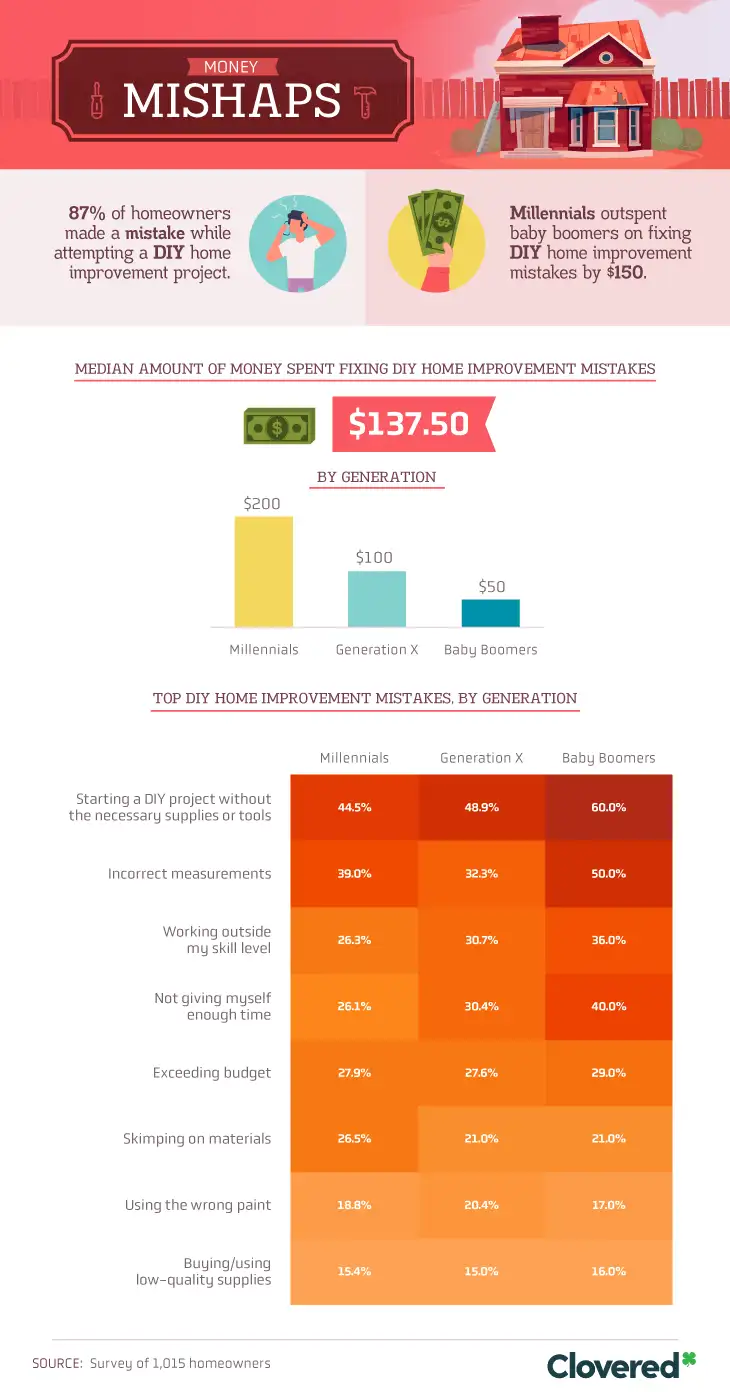
Professional or DIYer, mistakes happen. But when you’re taking projects upon yourself to save money, the mistakes may end up costing more than hiring a professional would. On average, people spend $137.50 fixing mistakes made during DIY home improvements. Millennials report spending an average of $200 fixing DIY mistakes – four times as much as baby boomers.
The significant difference between generations regarding money spent on mistakes may be due to the difference in types of mistakes most commonly made by each generation. Sixty percent of baby boomers start DIY projects without the necessary supplies or tools – the most common mistake made across all generations.
Gen Xers used the wrong paint more than baby boomers and millennials, and the youngest generation was the most likely to skimp on materials.

Improvement Injuries
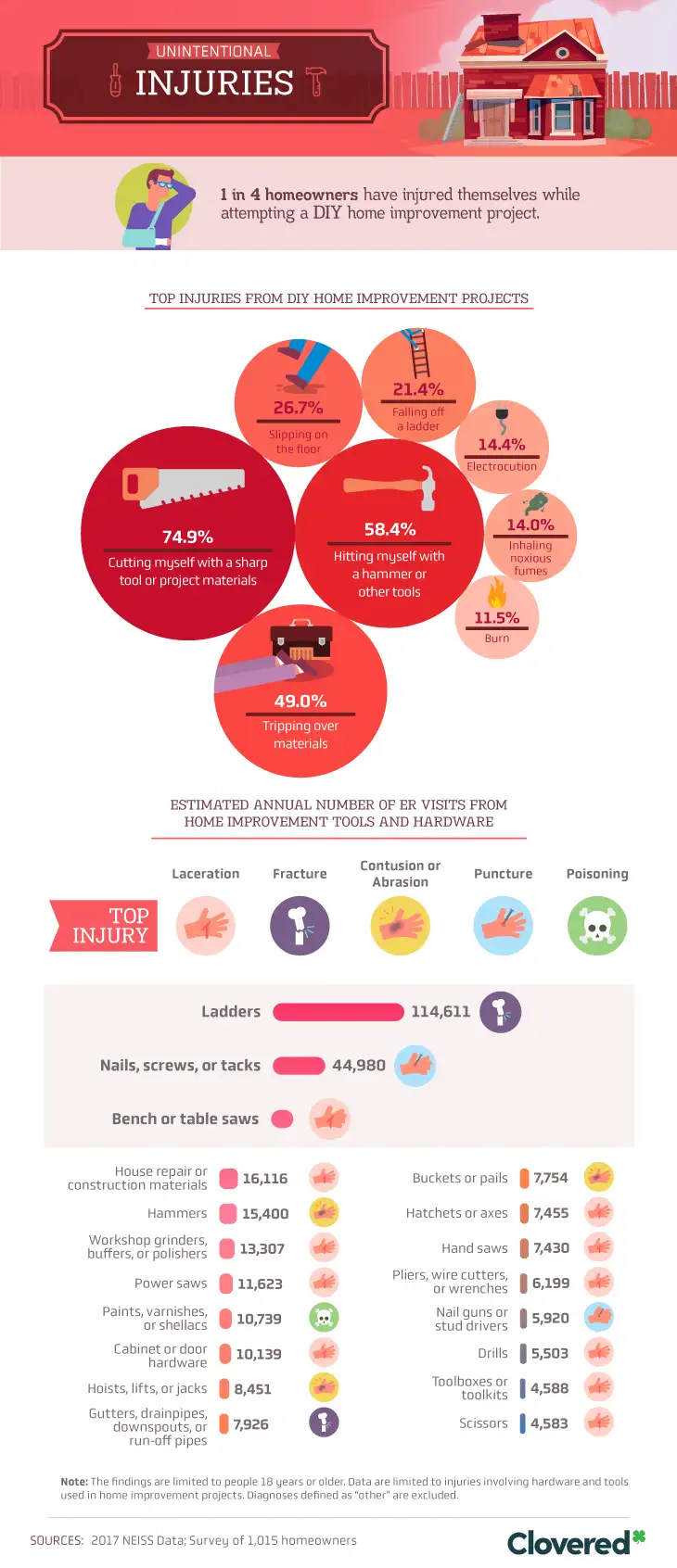
Most people attempt home improvement projects by themselves with the notion that they’ll successfully hit the nail on the head. However, slip-ups happen, and cuts, bruises, and serious injuries may occur.
Of those we surveyed, 1 in 4 homeowners had been injured while attempting a DIY home improvement project. Around 75 percent of injuries involved cuts from sharp tools or project materials, and 58 percent of respondents said they hit themselves with a hammer or other tool.
DIY injuries often need more than just a small bandage, though. Data from the National Electronic Injury Surveillance System (NEISS) shows the most ER visits are due to injuries by ladders, with fractures being the most common result.
Studies have shown these injuries aren’t necessarily involved in the height from which one falls, but rather, severity is dependent upon the person’s age. Almost 45,000 ER visits are due to accidents involving nails, screws, or tacks, which often result in puncture wounds.
Heed the Advice
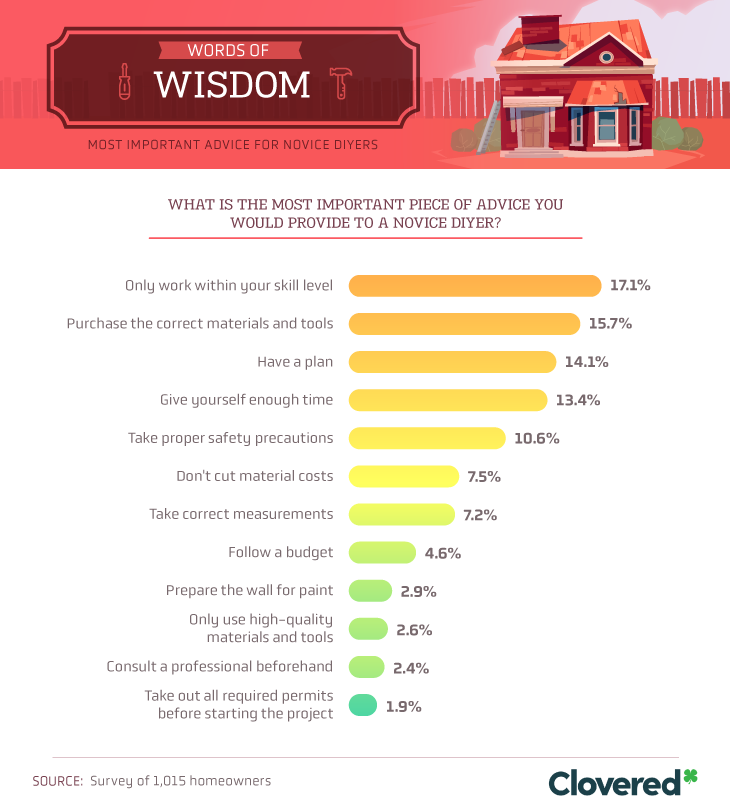
If you’re thinking of taking up a home improvement project by yourself, take advice from those who have made the mistakes for you. The biggest piece of advice from our respondents is to only work within your skill level.
Attempting to complete projects that might be too technical is a quick way to get injured. Stick to what you know and the project is more likely to go smoothly without ending in mistakes or injuries. Respondents also recommended purchasing the correct materials and tools and having a set plan.

We partner with the nation’s top homeowners insurance companies so you can get a custom policy at an affordable price.
Accidents Happen
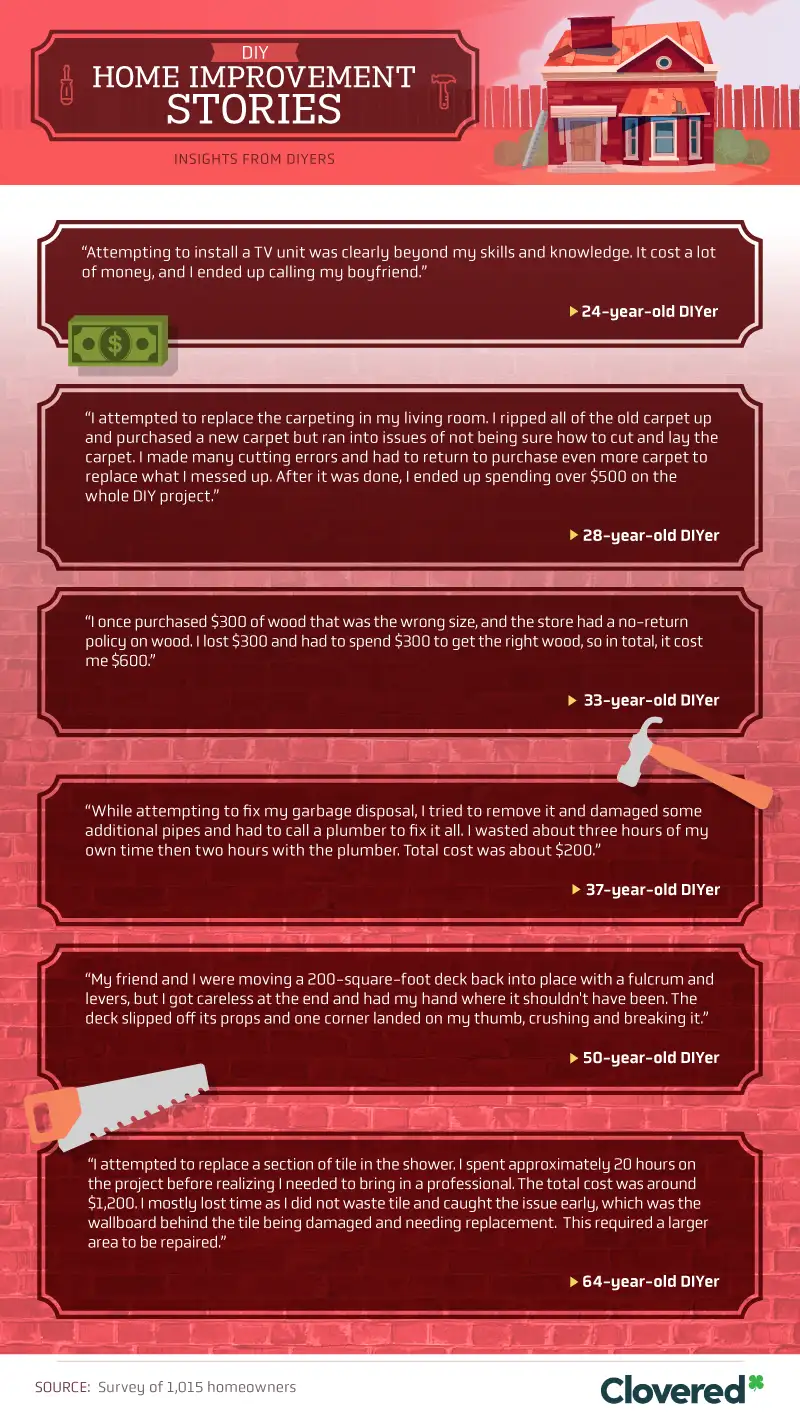
Not heeding the warnings or taking advice from experienced DIY-ers can lead to some of the horror stories above. If the mistakes are severe enough, it may be more than just money you’re gambling with.
Stay Protected
Do-it-yourself projects have become more and more popular, especially in the home improvement department. While some of these projects can save you a ton of money, consider the price of a professional before getting your hands dirty.
If doing it yourself seems to be the best option, make sure you’re prepared and operating within your skill level. Mistakes and injuries can happen — turning a home improvement project into a potential home-wrecking disaster.
Wearing protective gear while attempting projects can save your fingers, but what about your home? Insuring your home with homeowner’s insurance is the best way to protect against DIY mistakes. Picking insurance doesn’t have to break the bank, though.
At Clovered, we help you find the best plan to cover your needs at a cost you’re comfortable with. Whether your home is a house, condo, or an apartment, we’ve got you covered. Before you pick up that hammer, visit us online today.
Methodology and Limitations
We collected responses from 1,015 homeowners by administering online surveys via Amazon’s Mechanical Turk. Of the total 1,015 people polled, 12.0 percent identified as baby boomers, 31.9 percent as Gen Xers, and 56.1 percent as millennials.
All other generations were excluded from certain breakdowns due to insufficient sample sizes. To qualify for the survey, participants were required to be homeowners and to have attempted a do-it-yourself (DIY) home improvement project.
The highest and lowest potential prices for DIY home improvement projects were determined by averaging project estimates gathered from reputable online sources, which included: fixr.com, homewyse.com, angieslist.com, and homeadvisor.com.
The main limitation of this project is that DIY price points were solely based on participant estimations
To determine the number of estimated annual visits to the emergency room, we collected data from the National Electronic Injury Surveillance System (NEISS) for 2017 (latest year available). The data was filtered to enable our team to analyze injuries occurring in the home and as a result of using home improvement tools or hardware.
The information we are presenting relies on documented ER visits and does not include unreported injuries.

We partner with the nation's top homeowners insurance companies so you can get a custom policy at an affordable price.
The editorial content on Clovered’s website is meant to be informational material and should not be considered legal advice.
